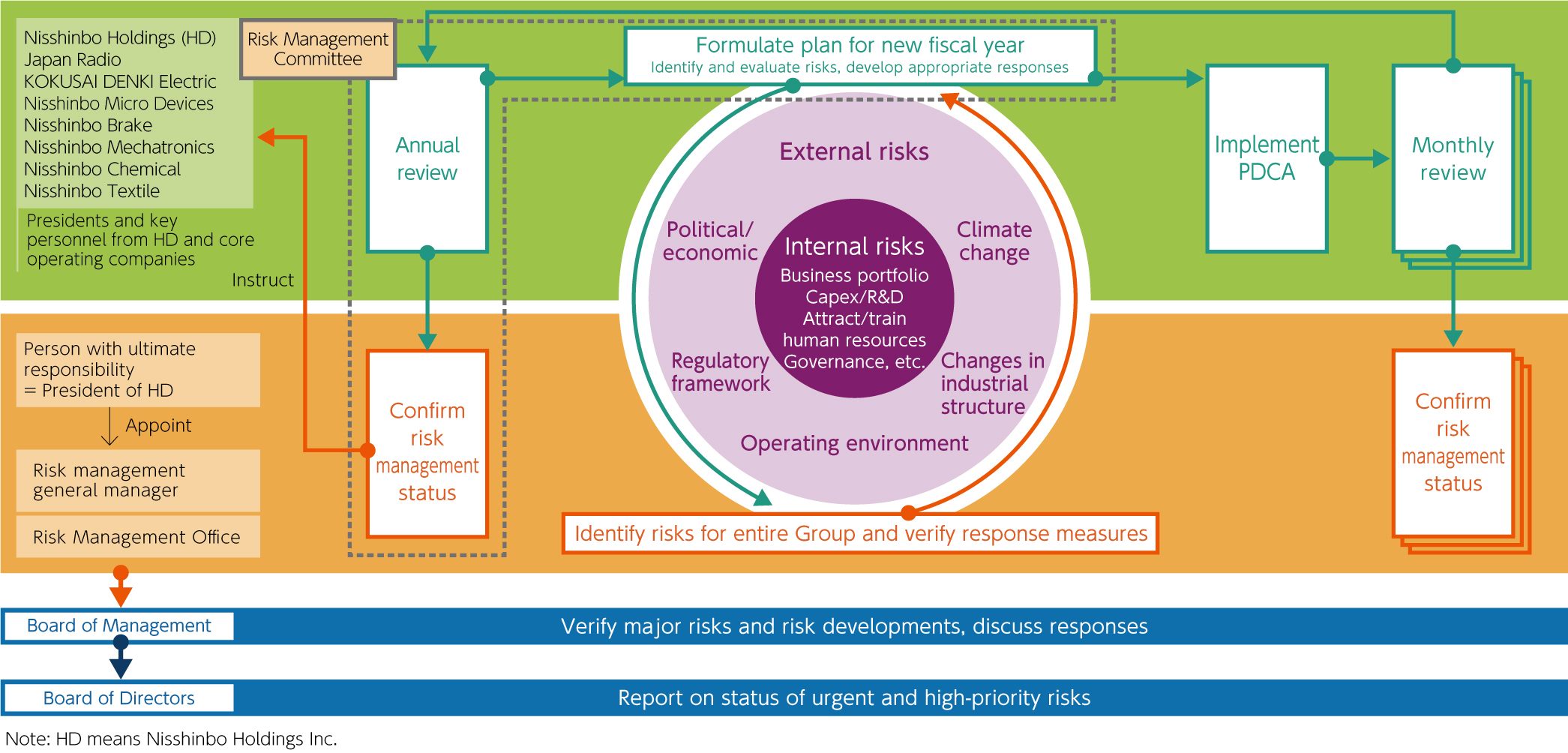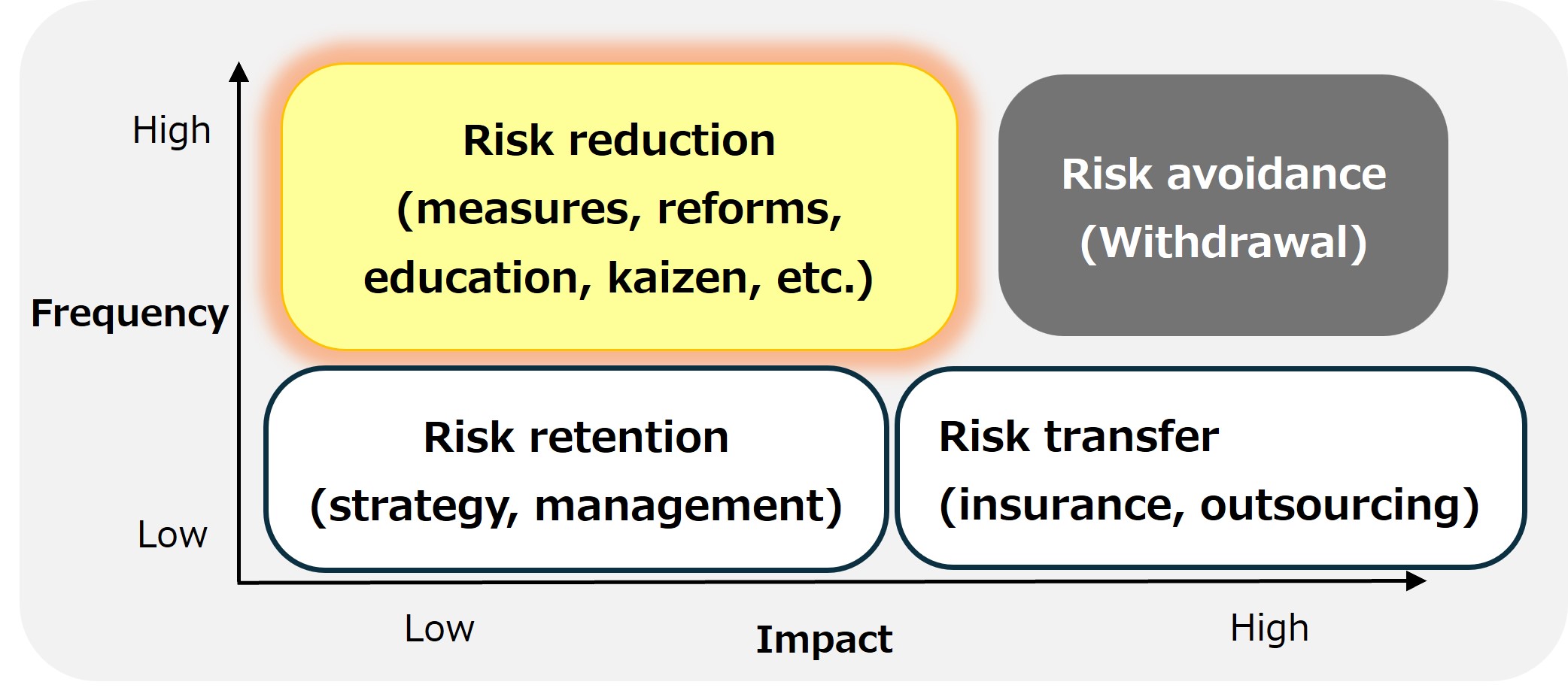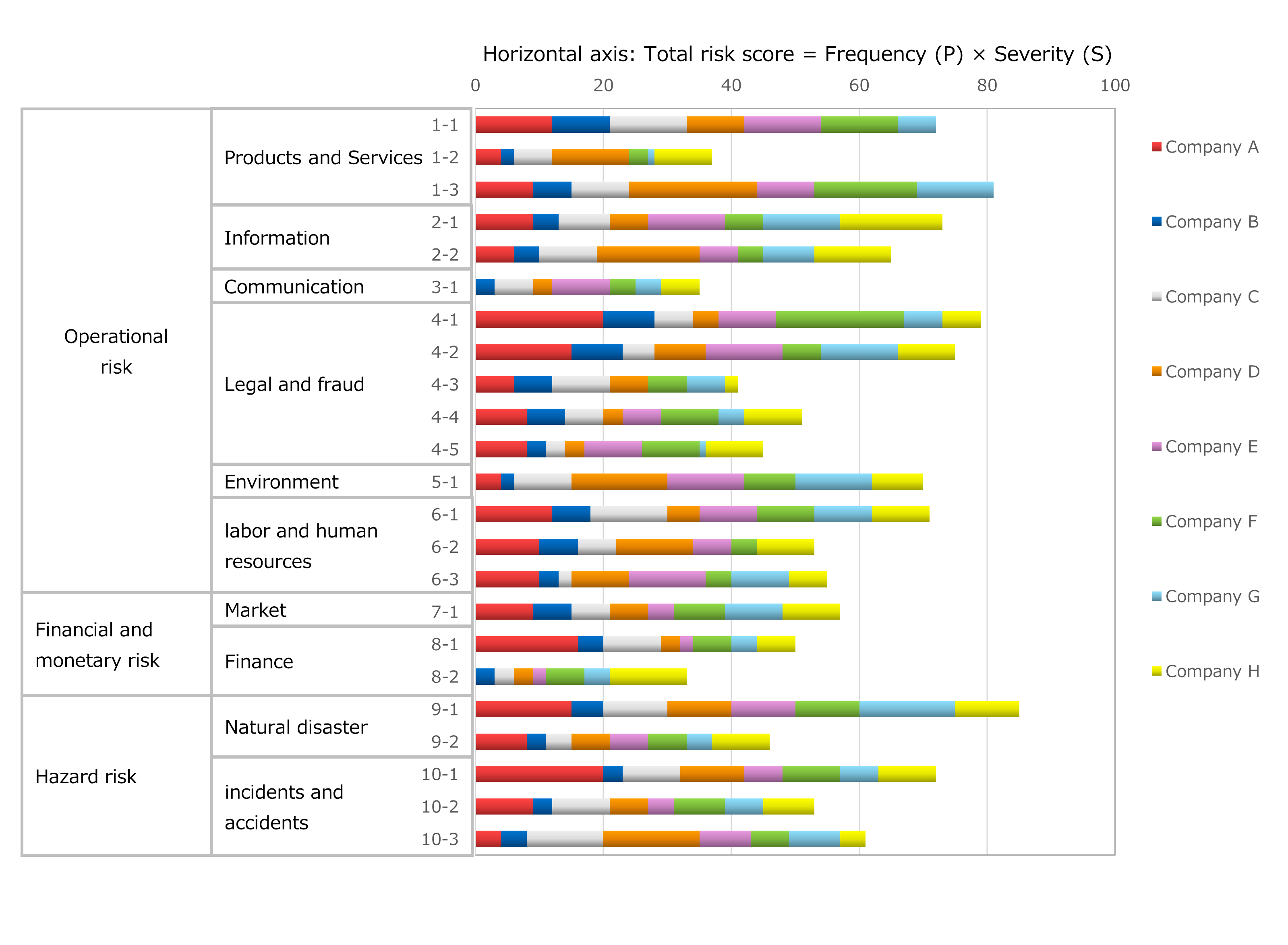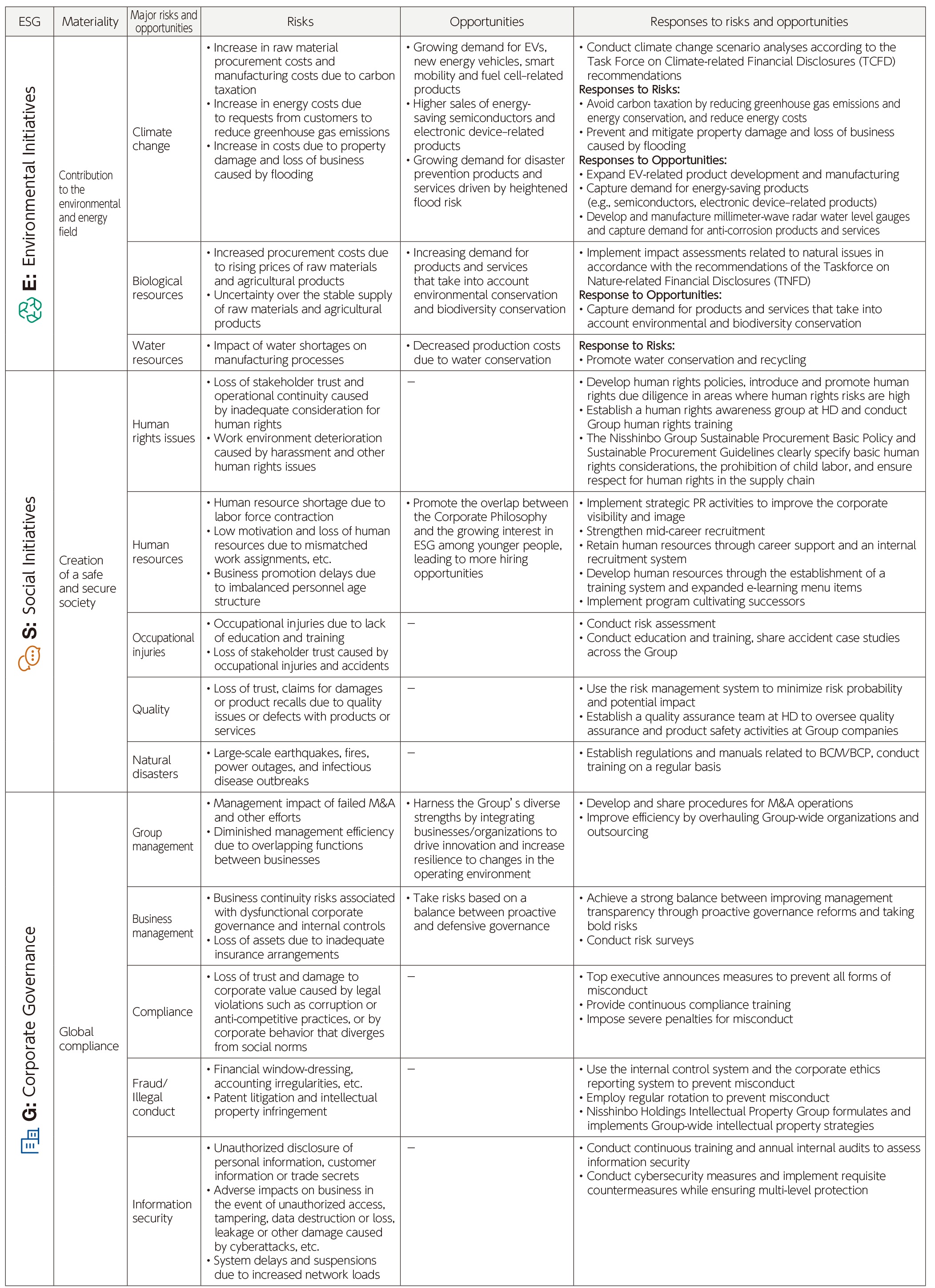Basic Concept
The Nisshinbo Group's basic concept to risk management is clearly stated as action guidelines in the "Risk Management Regulations."
Action Guidelines for Risk Management
The Nisshinbo Group aims to fulfill its social responsibility, secure trust, and achieve lasting development by accurately addressing management risks that may have a significant impact on the smooth operation of its business. All officers and employees shall recognize the importance of risk management, set risk management targets, and strive to implement and improve them, while complying with the following items.
- ① Comply with laws, regulations, and rules, and conduct business activities in accordance with socially accepted norms.
- ② Protect the health, lives, and safety of its Group's officers, employees, and related parties.
- ③ Protect the activities and assets of its Group's stakeholders, shareholders, and customers.
- ④ Enhance the reputation of the Group in society by accurately responding to fair and reasonable social demands.
While the main objective of its risk management regulations is to minimize losses in the event of management risk, the Group will also consider it important to view management risk as an opportunity for sustainable growth. To this end, the Nisshinbo Group will create new growth opportunities by understanding and analyzing various changes in the business environment and contributing to society based on business policies derived from the Group's corporate philosophy.
Promotion System
The Nisshinbo Group has established a risk management system, shown in the diagram below, to appropriately address business risks and minimize any losses associated with those risks.
The President and the Director of Nisshinbo Holdings Inc. is the chief risk management officer, and the Chief Exective officer appoints a general manager from among the Managing officer of the Company. The person responsible for overall risk management is normally the executive officer in charge of the Risk Management Department of the Company. The Risk Management Secretariat is located in the Risk Management Department.
The Risk Management Committee, consisting of the chief executive officer, the general manager, and members that include the presidents of each core company, meets annually in January. The committee reports on the previous year's review and deliberates on the formulation of plans for the new fiscal year (priority management risks for each business, etc.).
Risk Management Structure

For an overview of our organizational structure for promoting sustainability, please see "Promotion System for Sustainability Activity".
Risk Management
Taking into account the economic impact of identified risks, the Nisshinbo Group strives to respond by category to any of the four types of risk that can be avoided, mitigated, transferred, and held.
Risk-based response

Risk Mitigation Mechanism through Risk Management
For risks that can be mitigated, the Nisshinbo Group is working to reduce risks by implementing a one-year PDCA cycle. Specific procedures are managed based on the Group's "Risk Management Regulations." Every fiscal year, management risks are identified for each business. Each risk is rated on a five-point scale, with the higher score given to the risk with the highest impact and probability of occurrence, and the management risks that exceed a certain level are identified by multiplying the impact and probability of occurrence.
Risk extraction process (example of risk distribution visualization)

Each business will identify all operational risks and select several operational risks for close monitoring during the new fiscal year and report them to the Risk Management Secretariat. The Risk Management Office confirms the reported management risks with the person in charge of risk management in each business and adjusts the management risk items as necessary, taking into account the risk trends and leveling of the entire Nisshinbo Group. The adjusted management risks are approved by the person in charge of each business (the president of the core company) to determine the management risks to be monitored in the new fiscal year.
The secretariat reports the management risks to be monitored for each business to the Risk Management Committee in January, and risk management activities for the new fiscal year begin. Each business will report its risk management activities as one of the reporting items in the monthly report. The secretariat supports the activities of each business by confirming the reports and interviewing them on the updated progress and other matters as necessary. At the end of the fiscal year, each business reviews the activities for the year, evaluates whether the significance of impacts and probability of occurrence have decreased, and coordinates the evaluation results with the secretariat. By repeating this process every year, the Group will reduce risks.
Major Risks and Opportunities
The followings are the major risks and opportunities that management perceives as having the potential to seriously affect the consolidated company's financial position, operating results, and cash flows, among other matters related to business conditions and accounting conditions.

Specific Initiatives of The Nisshinbo Group
5th Sustainability Promotion Plan (to be achieved by FY2024)
In the 5th Sustainability Promotion Plan with FY2024 as the target year, the Nisshinbo Group set the following item as target and KPI to promote risk management activities as a priority activity and achieve the goals of operating a risk management system that responds to the external environment.
Continuous operation of the risk management system in response to the external environment
The persons in charge of each project and the secretariat collaborated to operate a risk management system that includes a PDCA cycle, and worked to mitigate risks through risk management activities.
6th Sustainability Promotion Plan (to be achieved by FY2027)
In the 6th Sustainability Promotion Plan, which targets FY2027, the Nisshinbo Group will continue to focus on promote risk management activities and will set the following qualitative target. The Nisshinbo Group will strive to enhance the level of its activities.
Operating a risk management system that responds to the environment
Please refer to "Sustainability Promotion Plan and KPIs" for details regarding of the "Sustainability Promotion Plan."
Activities Related to Risk Management
Nisshinbo will introduce several topics from the content reported to the Risk Management Committee in January 2025.
-
Cyber Risk Countermeasures
Against the backdrop of advancing digitalization and heightened geopolitical risks, cyber risks are increasing globally. The Nisshinbo Group is also working to reduce cyber risks, mainly through its Information Systems Department and with the cooperation of external experts, in order to prepare for attacks involving unauthorized access from outside the Company. As part of the risk management activities for FY2025, the Group will focus on monitoring cyber risks in multiple business groups, starting with employee education and awareness, followed by targeted email training, risk transfer through insurance, and further system enhancements. -
Confirmation of BCP/BCM operational status
The Group's Risk Management Office conducts interviews with each business every six months to review their risk management activities. In August 2024, following the announcement of special information on the Nankai Trough earthquake (warning of a massive earthquake), Nisshinbo recognized the need to confirm the status of the maintenance and operation of BCP/BCM regulations and manuals and conducted a questionnaire survey of all domestic and overseas subsidiaries. While most companies have BCP/BCM plans in place to address general crises, some companies prepared documents specifically addressing individual crises, such as cyberattacks, fires, earthquakes, floods, power outages, and infectious diseases. Through the survey, Nisshinbo personnel not only gained an understanding of the current situation but also identified opportunities to review and update relevant documents to ensure they remain up to date.
Identification of Emerging Risks
Whenever an event that may affect the business occurs, the president, executive officers, and department managers of relevant departments receive reports by sending the information at the same email address.
In the risk management regulations, Nisshinbo Group established standards by listing specific examples of risks that should be reported. By identifying and sharing risks as soon as they become apparent, Nisshinbo Group is prepared to implement the necessary countermeasures before they have a significant impact on business. In FY2024, there were 36 reported risks, a decrease of 5 from the previous fiscal year (because of the decrease in the number of natural disasters). But fortunately, the majority of events were at a level that could be handled by each company and did not have a significant impact on business continuity.
Nisshinbo Group will continue to ensure that the Group is well informed of this so that it can be used effectively as a tool to inform the first responders of risks that have emerged.

